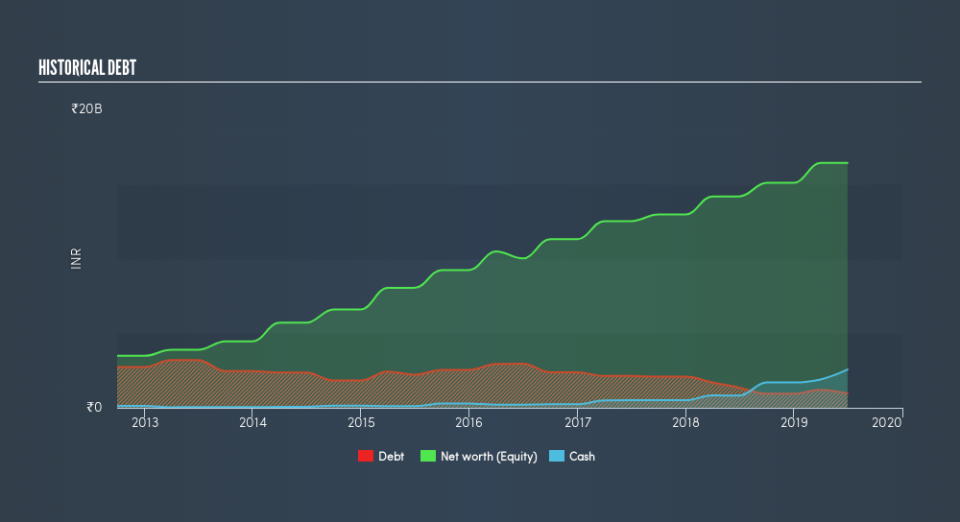These 4 Measures Indicate That Kajaria Ceramics (NSE:KAJARIACER) Is Using Debt Reasonably Well

The external fund manager backed by Berkshire Hathaway's Charlie Munger, Li Lu, makes no bones about it when he says 'The biggest investment risk is not the volatility of prices, but whether you will suffer a permanent loss of capital.' So it seems the smart money knows that debt - which is usually involved in bankruptcies - is a very important factor, when you assess how risky a company is. Importantly, Kajaria Ceramics Limited (NSE:KAJARIACER) does carry debt. But is this debt a concern to shareholders?
What Risk Does Debt Bring?
Generally speaking, debt only becomes a real problem when a company can't easily pay it off, either by raising capital or with its own cash flow. If things get really bad, the lenders can take control of the business. However, a more common (but still painful) scenario is that it has to raise new equity capital at a low price, thus permanently diluting shareholders. Of course, plenty of companies use debt to fund growth, without any negative consequences. The first thing to do when considering how much debt a business uses is to look at its cash and debt together.
See our latest analysis for Kajaria Ceramics
What Is Kajaria Ceramics's Debt?
As you can see below, Kajaria Ceramics had ₹949.4m of debt at March 2019, down from ₹1.35b a year prior. But on the other hand it also has ₹2.57b in cash, leading to a ₹1.62b net cash position.
A Look At Kajaria Ceramics's Liabilities
Zooming in on the latest balance sheet data, we can see that Kajaria Ceramics had liabilities of ₹5.87b due within 12 months and liabilities of ₹1.46b due beyond that. Offsetting these obligations, it had cash of ₹2.57b as well as receivables valued at ₹4.82b due within 12 months. So these liquid assets roughly match the total liabilities.
This state of affairs indicates that Kajaria Ceramics's balance sheet looks quite solid, as its total liabilities are just about equal to its liquid assets. So while it's hard to imagine that the ₹75.4b company is struggling for cash, we still think it's worth monitoring its balance sheet. Succinctly put, Kajaria Ceramics boasts net cash, so it's fair to say it does not have a heavy debt load!
Kajaria Ceramics's EBIT was pretty flat over the last year, but that shouldn't be an issue given the it doesn't have a lot of debt. There's no doubt that we learn most about debt from the balance sheet. But ultimately the future profitability of the business will decide if Kajaria Ceramics can strengthen its balance sheet over time. So if you want to see what the professionals think, you might find this free report on analyst profit forecasts to be interesting.
But our final consideration is also important, because a company cannot pay debt with paper profits; it needs cold hard cash. Kajaria Ceramics may have net cash on the balance sheet, but it is still interesting to look at how well the business converts its earnings before interest and tax (EBIT) to free cash flow, because that will influence both its need for, and its capacity to manage debt. Looking at the most recent three years, Kajaria Ceramics recorded free cash flow of 42% of its EBIT, which is weaker than we'd expect. That's not great, when it comes to paying down debt.
Summing up
While it is always sensible to investigate a company's debt, in this case Kajaria Ceramics has ₹1.6b in net cash and a decent-looking balance sheet. So we are not troubled with Kajaria Ceramics's debt use. Over time, share prices tend to follow earnings per share, so if you're interested in Kajaria Ceramics, you may well want to click here to check an interactive graph of its earnings per share history.
If, after all that, you're more interested in a fast growing company with a rock-solid balance sheet, then check out our list of net cash growth stocks without delay.
We aim to bring you long-term focused research analysis driven by fundamental data. Note that our analysis may not factor in the latest price-sensitive company announcements or qualitative material.
If you spot an error that warrants correction, please contact the editor at editorial-team@simplywallst.com. This article by Simply Wall St is general in nature. It does not constitute a recommendation to buy or sell any stock, and does not take account of your objectives, or your financial situation. Simply Wall St has no position in the stocks mentioned. Thank you for reading.

 generic
generic 
